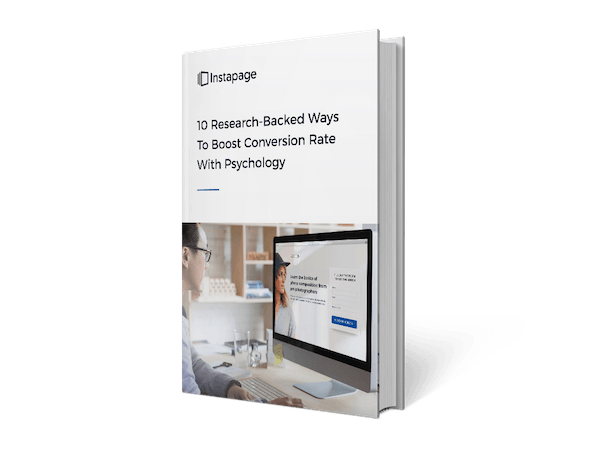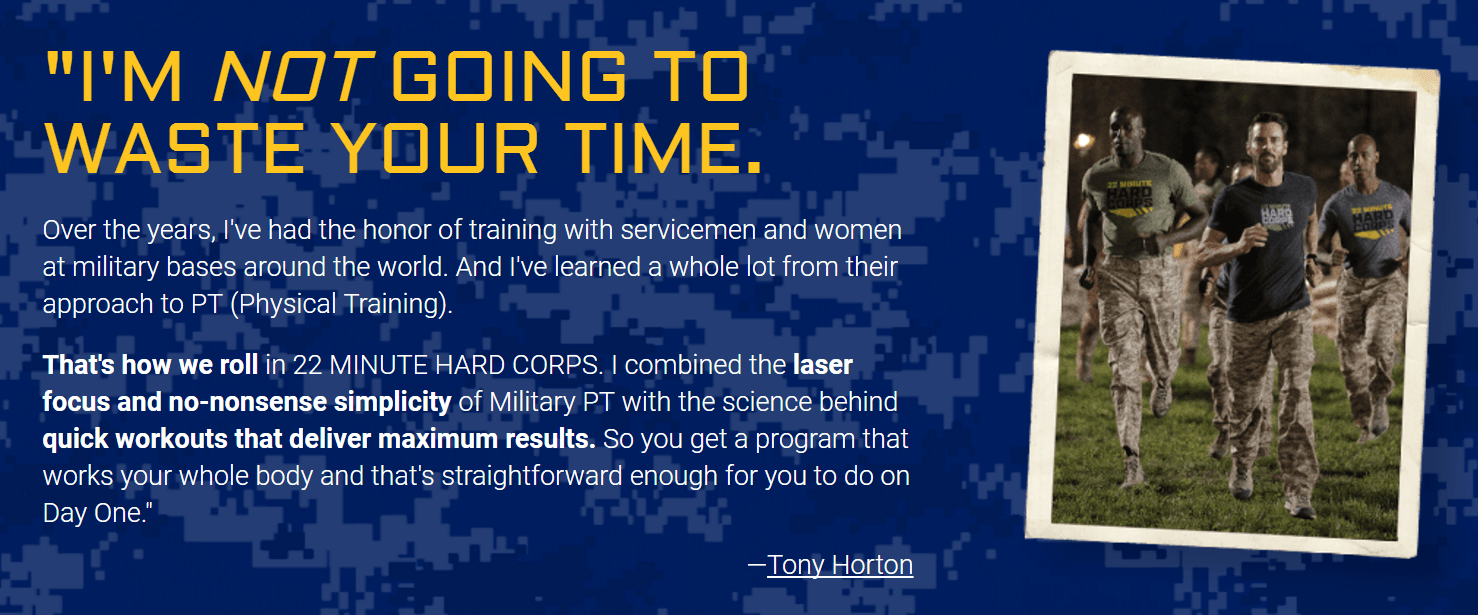Today’s lesson on persuasive marketing is brought to you by a writer, a waiter, and among others, a researcher in disguise.
Surprisingly, they can all teach you how to improve your post-click landing page design and overall marketing strategy with psychological principles proven to inspire action.
Those principles are called “reciprocity” and “authority,” and they’re two of ten that every marketer should take advantage of to boost ROI. To learn the other 8 principles of psychology that will give your post-click landing page a persuasive edge, download the new Instapage resource:

Two principles of marketing psychology central to post-click landing page success
All the best marketers are part psychologist. They know what their prospects need, and how to give it to them with elements that mentally guide them toward conversion. Two psychological principles, authority and reciprocity, power some of those elements.
Reciprocity can generate goodwill for your business, and authority can boost the perceived value of your offer exponentially. Here’s how to use them both in your marketing strategy.
Reciprocity
Copywriter Dean Rieck and his client have just finished a casual dinner out. When the bill arrives, Rieck’s guest snatches it quickly. “I’m happy to pick up the tab,” he says.
The copywriter accepts his client’s generosity, but reluctantly:
I do appreciate it, but something feels wrong. I can’t figure it out. I get free food, but I’m uneasy about something.
Two weeks later, I’ve forgotten all about it. But when the same client asks me to do something extra on a project — something not in our contract — I agree without thinking. He asks, and while I would usually refuse, I say, “Yes.”
Rieck has just been compelled by the power of reciprocity. Here’s how:
How the principle of reciprocity works
Whether they realize it or not, victims of reciprocity enter a social contract that makes it difficult for them to say “no” to a request. In the above example, Rick describes feeling “uneasy about something” after having his meal paid for, when there was seemingly no reason to.
Two weeks later, he discovered the reason for that feeling: He was indebted to his client for picking up the check, which made it harder for him to turn down extra work when that client requested it later.
In a nutshell, that’s reciprocity. It’s the “I owe you” feeling after someone does you a favor, which, more often than not, compels you to return that favor. And no one is immune to it.
Politicians routinely extend generosity knowing that it will someday be returned. Pharmaceutical representatives offer gifts to doctors knowing that it can convince them to prescribe a particular brand of medication.
As you’ll see, research shows there’s little the rule of reciprocity can’t accomplish. The “I owe you” feeling is so strong that it’s extremely difficult to resist, even if you don’t know the person you’ve entered the contract with.
Research on reciprocity
The origin of reciprocity can be traced back thousands of years. Early on, before members of a society paid or bartered for goods, they relied on each other to share resources. The principle of reciprocity ensured that a generous act, like sharing food, would be repaid.
Since then, countless studies have reinforced the power of reciprocity. Here are a few:
- In 1974, sociologist Phillip Kuntz sent Christmas cards to around 600 strangers. Despite not knowing him at all, over 200 of those people sent return cards to Kuntz.
- An experiment set in a restaurant showed that waiters could increase tips by 3% when bringing a candy along with the bill. When waiters allowed patrons to choose two pieces of candy, tips increased 14%. When waiters delivered one piece of candy, walked away, then returned a minute later to gift a second candy to the group because it had been “such a great table,” tips increased by 21%.
- At Cornell University in 1971, researcher Dennis Regan set up an experiment on “aesthetics” — or at least, that’s what he told participants — who were to evaluate art in pairs. In fact, the study was on compliance, and it showed that when the second evaluator (who was actually a researcher in disguise) gifted the participant with a soft drink during the study, he was twice as likely to purchase raffle tickets from the second evaluator after the study.
- One study by the Behavioral Insights Team involved asking investment bankers to donate a day’s worth of their salary to charity. Researchers found that when that request was accompanied by a gift bag of candy, double the number of bankers chose to donate.
In transactions both monetary and social, it’s clear reciprocity is powerful — but how do you incorporate it into your digital marketing strategy?
Using reciprocity in your digital marketing
To put yourself in a position to benefit from the rule of reciprocity, you have to give before you get. Some ways to incorporate the principle into your marketing strategy:
- Give away free, useful information to your prospects in the form of blog posts, reports, and guides.
- Feature other businesses in your content, and notify them when you do, like we did with this post about CB Insights’ marketing stack.
- Give other marketers access to your audience by allowing them to guest blog on your website. Here’s a recent guest post by Joei Chan from Mention.
- Share news and updates from other accounts on social media. Nathan Chan from Foundr built an Instagram audience of 400,000 in just 12 months with this technique.
- Offer data to journalists and content to blog managers. Buffer generated 100,000 users through guest posts alone in its first 9 months.
- Make all your post-click landing page form fields optional. It’s a seemingly counterintuitive strategy, but it boosted lead quantity by 30% for one business.
To reap maximum benefits from the rule of reciprocity:
1. Ask soon after gifting. The urge to repay a debt is strongest is immediately following the act of generosity.
2. Make the gift relevant. One study showed that fast food patrons were more likely to overspend when they were given a free sample of yogurt compared to a free keychain before their meal. The reason is simple: They’re in a restaurant because they’re hungry. The personalized, relevant gift engages a more “muscular version” of reciprocity, says Cialdini.
3. Give more to get more. In the tipping experiment, one piece of candy brought a 3% increase in tips compared to none, but two pieces brought a 14% increase. The more you give, it shows, the more you’re likely to get.
4. Make the gift unexpected. In the same tipping experiment, while two pieces of candy brought a tip increase of 14%, the “1+1” condition (in which waiters gifted one mint, then returned to gift another to “such a great table”) produced an increase of 21%. The reason was the unexpectedness of the tip.
Keep in mind, reciprocity can work both ways. Other research on the principle shows that people will take “two eyes for an eye,” so ensure you give more than you take.
Authority
Would you inflict pain on a stranger if a doctor told you to? In 1963, researcher Stanley Milgram aimed to find out in what’s become maybe the most widely known experiment of all time. It was set up like this:
Upon arrival, each participant was introduced to a second participant, who was actually a confederate working for the experimenter. They drew sticks to see which would be the learner and which would be the teacher, but the process was rigged to ensure the participant was always the teacher.
- The learner (confederate) sat behind a curtain with electrodes attached to him. He would answer questions asked by the experimenter.
- The teacher (participant) would operate a switchboard connected to those electrodes. When the learner answered a question incorrectly, he would flip a switch and administer a shock.
Dressed in a grey lab coat, the experimenter instructed the teacher to deliver shocks between 15 and 450 volts to the learner throughout the experiment. When he was “shocked,” the learner would shriek.
By the end, nearly two-thirds of subjects delivered a 450-volt shock to the man (labeled on the switchboard as “danger — severe shock”), regardless of how much pain he was seemingly in. All participants administered a shock of 300 volts.

Milgram wrote about the results in a paper titled The Perils of Obedience:
“Stark authority was pitted against the subjects’ [participants’] strongest moral imperatives against hurting others, and, with the subjects’ [participants’] ears ringing with the screams of the victims, authority won more often than not.
The reason so many people were willing to harm a complete stranger? From the researcher himself: The authority principle.
How the principle of authority works
We’re raised from a young age to respect authority. Parents, teachers, and doctors are among those whose orders we’re taught to comply with, usually because they’re well-trained figures with good intentions.
That’s why, in the experiment, so few subjects disobeyed the order to administer even a fatal shock. Milgram claimed these people were in something called the “agentic state,” as opposed to the “autonomous state,” in which people are in control of their own actions. The agentic state is defined as:
“A state of mind in which a person will allow other people to direct their behaviors and pass responsibility for the consequences of the behaviors to the person telling them what to do.”
For people to enter the agentic state, two conditions have to be present:
1. The person giving the orders must be perceived to be qualified to direct other people’s behavior.
2. The person being ordered about is able to believe that the authority will accept responsibility for what happens.
One of those is crucial to using authority in marketing to get people to take action.
Using authority in marketing
When people evaluate an offer or piece of marketing collateral, the “who” it’s associated with can, in many cases, be more important than what it is. Rieck explains:
“Which diet will take off those extra pounds? Well, here’s a nationally-recognized weight-loss authority who says she has the answer. She’s got a doctorate in nutrition. She dresses in exercise gear. And her books and tapes are in every bookstore. Titles, clothes, and trappings. Sure, we’ll give it a whirl.”
“Titles, clothes, and trappings” refers to the Robert Cialdini’s three indicators of authority, which people use to meet Milgram’s first condition for entering the agentic state:
- Titles – Dr., Prof., Ph.D., President, Founder, CEO, Industry experts
- Clothes: Uniforms, suits, outfits ( army fatigues, expensive suits, labcoats)
- Trappings: Accessories that come with certain roles (e.g. police badges, religious, rosaries, nice cars, etc.)
By using all three, you can demonstrate to prospects that you’re qualified to dictate their behavior. Let’s take a look at some examples from a few post-click landing pages.
1. Sam Ovens

Sam Ovens claims he can get you high-ticket coaching and consulting clients. Does it look like he can? To us, the answer’s “yes.”
He’s wearing what looks to be an expensive outfit, sitting on a wooden desk that’s surrounded by high-value design accessories (leather chairs, gold paperweights, and… is that an antique motorcycle in the background?).
Look out those windows and you’ll notice that Sam’s office features not only a beautiful view, but a beautiful view among skyscrapers, which means he’s in a major city. And that means his office is likely mighty expensive to maintain.
2. The 21-day fix

Celebrity trainer Autumn Calabrese is the face of Beach Body’s 21-Day Fix program. By evaluating her authority, prospects can determine she’s capable of whipping them into shape.
First, she’s dressed the part — in workout clothing. It makes her look like a trainer right off the bat. Second, that workout attire has been chosen to specifically showcase her midriff, which is flat and toned — a fit look many aspire to. Third, she’s holding two containers full of healthy food, which subtly indicates she knows what to eat to achieve her aesthetic.
3. Beach Body Hard Corps

Here’s another Beach Body program, the 22-Minute Hard Corps, led by trainer Tony Horton. His authority appeals to a more intense audience, as indicated by his army fatigues and more muscular physique (not to mention the name of the program “Hard Corps”). It shows him squatting in the grass, leading a workout of at least four people. His position above them subtly signals he’s in charge and that he’s able to discipline prospects into getting fit.
But are looks everything?
Titles, clothing, and accessories can help a prospect determine whether someone is qualified to offer their product or service — but it’s not always enough. Before visitors download or sign up or buy, many times they need an additional indicator, like credibility.
Credibility
Credibility is like authority’s more accomplished sibling. Authority talks the talk, but credibility walks the walk. A definition:
Credibility refers to the believability and reliability of information received from outside sources. When assessing the credibility of a source, it is necessary to evaluate the trustworthiness and expertise of the person or persons providing this information.
Achieving credibility comes down to proving knowledge and expertise. Your prospects will ask:
- Is this person/business knowledgeable on what they’re offering?
- Can this person/business be trusted?
With a few marketing techniques, you can assure your prospects of both. To demonstrate expertise, list your qualifications, your education (if applicable), where you’ve been featured, who you have worked with, and awards you’ve won.
Here’s an example from that same Beach Body page, which cites Tony Horton’s experience training military service members around the world:

Here’s another example, courtesy of Logical Position, which showcases awards to prove expertise:

Here’s one last example from a content marketing agency, Louder.Online:

As far as credibility is concerned, demonstrating your trustworthiness is a little more difficult. When you tell them that they should claim your product because it’s “the best in the world” or “the most powerful on the market,” they’ll doubt you because you have a stake in the outcome.
That means, the less reason you have for recommending a product or service, the more persuasive you become. Dean Rieck offers another example:
If you’re writing a letter to raise funds for a conservative cause, imagine how powerful it could be to have a liberal delivering the message. If a liberal buys into the idea, it must be convincing!
If you can’t personally separate yourself from your offer, it’s still possible to convince prospects that it’s as good as you say it is. To achieve trustworthiness, you’ll need help from social proof.
To learn how to use social proof, and 9 other psychological principles to boost conversions, download the new Instapage resource here.
Boost conversions with psychological principles of advertising and marketing
Do you use reciprocity and authority in your marketing? Which psychological principles do you use to boost conversions?
Let us know in the comments, then create a post-click landing page that converts with the help of psychology and 100% customizable templates from Instapage.
